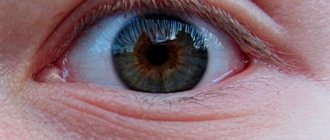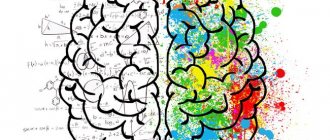When and how does somnambulism manifest itself?
When the slow-wave sleep phase is disturbed, childhood sleepwalking occurs. The child sleeps deeply, but in the parts of the brain responsible for movement, speech, and inhibition do not occur. The baby does not control his actions. He can talk or sing while sitting on the bed, walk around the house, orient himself perfectly.
For the first time, sleepwalking attacks begin in children at the age of 4-5 years. They last 10-20 minutes. After the child falls asleep, the deep sleep phase begins 2-3 hours later. At this time, the baby begins to talk and walk. A signal for sleepwalking can be light falling on the face from a lantern, advertising, or the moon. Any touch or sound encourages the child to stand up.
In a dream, with open eyes, a sleepwalker walks around the room and performs various actions. Usually they don’t pay attention to the fact that the teenager got up, went to the kitchen, drank water and went back to bed. Actions were performed in a borderline state between sleep and wakefulness, which is why they are classified as somnambulistic. In the morning the child will not remember this.
A sleepwalker can perform actions that he thought about before going to bed. The girl wanted to wash the dishes, but she was tired and went to bed. In the morning you discover that the dishes have been washed. The somnambulist performed the planned actions at night, but cannot remember them.
Mechanism of development of the disorder
Parents who encounter somnambulism in adolescents often panic, believing that their child is sick. This condition is not normal, but in most cases it does not pose a serious health hazard. As a rule, by the end of puberty, sleepwalking goes away on its own. It develops due to a violation of inhibitory processes in the brain or their improper distribution.
When we sleep, all body functions work in a saving mode; the heartbeat, blood circulation, breathing and other processes slow down. This state is ensured by inhibitory processes.
However, it happens that they do not affect the entire brain, the areas responsible for physical activity or speech do not turn off, but consciousness and memory fall asleep. As a result, the teenager performs some actions, but cannot adequately evaluate or remember them.
Sometimes it happens that inhibitory processes are incorrectly distributed in the brain; they affect all areas, but in insufficient quantities; in such a situation, the signs of sleepwalking will be less pronounced.
Causes
Why sleep is interrupted by walking or talking worries parents. Experts see the causes of sleepwalking in children as:
- excessive emotionality;
- constant state of anxiety;
- quarrels, conflicts in the family, kindergarten, school;
- chronic fatigue due to overwork;
- mental instability.
Children with epilepsy, neuroses, schizophrenia, and enuresis suffer from sleepwalking. Sometimes mental disorders are recognized by the presence of sleep disturbances. The epileptic nature can be determined by the following signs:
- The child is under 3 years old, or 13-16 years old.
- An attack of sleepwalking occurs in the second half of the night.
- The movements are stereotyped and repeated at regular intervals.
- It is difficult to wake up the baby.
- Brain activity is similar when the child is awake.
The nature of developing epilepsy can be recorded using an electroencephalogram. Often, due to genetic predisposition, problems with deep sleep begin.
Hereditary somnambulism
Sleepwalking in children is hereditary in most cases. 60% of sleepwalkers in the family were identified as somnambulists. Scientists from the USA and Canada, after conducting a series of studies, identified the DNA section responsible for the development of the disorder. It is located on chromosome 20. The presence of a copy of a region in the human genome by 50% leads to a predisposition to sleepwalking.
It is believed that out of 28 genes, the adenosine deamenase gene is responsible for the child’s behavior during the slow-wave sleep phase. But somnambulism cannot be completely attributed to genetic disorders. After all, there are children who walk and talk in their sleep, and their relatives did not suffer from this type of parasomnia.
Functional Nerve Disorders
The child reacts sharply to events that disturb him, which, as it seems to him, are associated with danger to life. At the same time, reactive states occur every night. The baby has nightmares, is tense, anxious, and screams in fear. Sleepwalking is more common when the body is weakened after or during an illness.
In a few minutes, the teenager walks around the house with his eyes wide open, answering questions. He is easily suggestible, so it is easy to persuade him to go to bed. The content of sleepwalking usually traces the events of the past day and emotional reactions to them.
With the improvement of the little patient’s well-being and a calm atmosphere in the family, the attacks stop for a long time.
Organic brain lesions
Concussion and injuries received by a teenager provoke the development of sleepwalking. With neuroinfections and intoxications, a sleep disorder is possible, but it differs in time and depth of occurrence from sleepwalking in healthy people.
The child may wander aimlessly around the house, bumping into objects and getting bruised. The cause of sleepwalking can be detected by complaints of headaches and fatigue. An accurate diagnosis will be made based on the results of an EEG of the brain. The examination will reveal foci of organic damage.
Hyperactive child and restless child. Increased excitability in a child
Symptoms and causes.
A hyperactive child cannot sit for a long time and do work associated with a static body position, often screams loudly and violently expresses emotions, has an attention deficit that does not allow him to concentrate on one thing, and is forced to discharge accumulated tension through physical activity.
That is, in the child’s nervous system, excitation significantly dominates over inhibition. The danger of increased excitability is a decrease in learning ability and, as a result, a child falling behind his peers in development.
It is important to understand the source of increased excitability and restlessness.
Therefore, the first thing we will offer you is to find out the reason for what is happening. There are three main options:
- This is your child’s normal natural temperament
and the intervention of a psychiatrist or doctor is not required. The child is mentally healthy and psychologically well-being. In this case, we will give you some recommendations, and you and your child will become noticeably more comfortable. - There is some psychological problem
that increases the child’s level of emotions, anxiety or aggression, for example.
Emotion requires release (discharge, realization), hence increased excitability and restlessness. The child is mentally healthy and does not need any medical treatment.
These kinds of psychological problems are quite easily diagnosed during a conversation with the child and parents, and then gently corrected. - Increased excitability and restlessness are a consequence of a medical problem.
We can talk about, for example, increased intracranial pressure, chronic inflammation somewhere (adenoids, tonsils), neuroinflammation, the consequences of birth hypoxia or trauma, childhood neurosis, a latent form of epilepsy. We also encounter more serious problems in our practice, such as autistic disorder and childhood schizophrenia. In this case, it is very important to find the true cause of what is happening, and only then will the treatment work effectively and safely.
Hyperexcitability, restlessness and hyperactivity as character traits
. If we talk about increased excitability and restlessness as characterological characteristics, this is possible if the child is extroverted and temperamental by nature. Or the child may copy this style of behavior from one of the family members. But we can talk about the norm only if this type of hyperactivity does not lead to health problems and if the child is not so excited that he stops sleeping normally, begins to get sick often, or lags behind in general development. Having severe disinhibition and excitability, the child cannot concentrate and master the skills that he is supposed to master by age.
Hyperactivity test
Active attention deficit:
1.Cannot concentrate on one thing, it is difficult to maintain attention;2.May forget what he was assigned or asked for;3.Likes to start a new activity, but cannot finish it;4.Cannot organize clearly his activities and maintain a routine; 5. It is difficult to maintain order, he may lose all his things; 6. Does not like monotonous tasks that require mental effort and attention; 7. May forget what he was assigned or asked for; 6. Doesn't respond immediately when approached.
Motor disinhibition:
1. Often moves restlessly (runs, jumps, climbs somewhere, fidgets in a chair and at the table); 2. Takes a long time to fall asleep and sleeps poorly, may wake up often4. Likes to talk a lot and uncontrollably.
Impulsiveness:
1. Poor control of one’s behavior; 2. Can’t regulate one’s actions and most often does not follow rules; 3. Poorly concentrates attention; 4. Can’t wait for something to finish or reward; 5. No precise line of behavior, strong variability in results and states; 6. May begin to answer without listening to the question; 7. Often interferes in someone else’s conversation and interrupts it; 8. Doesn't know how to wait, can run without waiting for the start.
If you find at least six of the listed signs in a child under the age of 7, we can assume that there is a tendency to hyperactivity. But only a specialist can make an accurate diagnosis. Where to start and who to contact with an overly excitable child?
If we are talking about a hyperactive, excitable and restless child, then it all starts with a detailed identification of the reason for what caused the child’s nervous system to remain in a state of excitement for such a long time. Most often in such cases, we recommend starting with an appointment with a pediatric neurologist and/or a child psychiatrist, and we also suggest getting a joint appointment with these two experts. This makes it easier and faster to determine the cause of increased excitability, to avoid treatment that is unnecessary in many cases, or to select exactly the treatment that your child needs. Based on the results of the initial examination, we can recommend additional laboratory and instrumental studies. We can also save you time and send a laboratory examination form to your email address for your initial appointment; to do this, you can fill out the “ask a doctor a question” form
.
Epilepsy or somnambulism?
A small group of epileptics have disorders of consciousness, expressed by night walking. Their difference from sleepwalking is the automation of movements in epilepsy. The patient suddenly gets out of bed and makes a series of stereotypical movements. This could be rearranging toys, books, sitting on the windowsill, walking from room to room.
At this time, the patient sees delusional pictures. After the attack, he lies down either in bed or in another place in the apartment. It is impossible to wake up an epileptic at this time. If a child has seizures during the day, then sleepwalking at night is a manifestation of epilepsy. It is difficult to distinguish the pathological condition from sleepwalking if seizures occur only during sleep.
Inhibition of the cerebral cortex during sleepwalking is only aggravated by pathological changes characteristic of an epileptic. Diagnostic examinations using an electroencephalogram will give a complete picture of epileptic automatisms and reveal its nature.
Increased anxiety in a child
The main reason
Anxiety in a child is the constant presence of the nervous system in a protective adaptive reaction to external situations and circumstances that the child for some reason assesses as dangerous (stress reaction). The child may not be aware of them, since he grows up in them from birth, and he is used to them, but subconsciously feels restless and unsafe.
Common symptoms of increased anxiety in a child:
- Anxiety in a child is often manifested by excessive attachment to the mother, since for the child she is the natural source of calm.
- Increased anxiety may be accompanied by excitability and hyperactivity, or, conversely, exhaustion of the nervous system, depression and apathy of the child. The brain cannot maintain anxiety and excitement indefinitely and quickly becomes exhausted.
- Very often, excessive anxiety is accompanied by immune depression (secondary immune deficiency due to stress) and frequent illnesses. For example, a child is highly susceptible to colds, brings all the infections that appear there from kindergarten, and spends a long time at home undergoing treatment.
- An almost obligatory and most common manifestation of increased anxiety is sleep disturbance; the child has trouble falling asleep and often wakes up. Or, at first glance, he sleeps enough and a lot, but does not get enough sleep and gets up in the morning in a bad mood.
- Fears (invents and endows safe things with dangerous properties).
First of all, it is necessary to understand in which area the causes of the problem lie. In psychological or medical
.
- Increased anxiety as a psychological problem.
- Anxiety in a child due to medical problems. This could be long-term brain damage during childbirth, hypoxia, asphyxia or birth trauma, after which the brain itself begins to generate anxiety in response to external circumstances. This may be increased intracranial pressure; in more complex situations, the causes may be autistic disorders, childhood psychoses, or even schizophrenia. And in order to help a child as effectively as possible, you need to accurately determine the nature of anxiety.
Progression of the attack
Attentive parents know what their child looks like when he sleepwalks at night. Somnambulists walk around the apartment with wide-open eyes and a detached face. At the same time, they can dress, play, and collect a briefcase. Sometimes the attack ends suddenly. Then children sleep sitting or lying on the floor. In the morning they wonder how they ended up in another place, since they don’t remember anything.
It is impossible to wake a child during sleepwalking. He may get scared and develop neurotic conditions.
In adolescents, somnambulism can occur until the age of 16. It proceeds with speaking and performing actions. It is important to monitor children so that they do not accidentally injure themselves. There have been cases when, in a state of sleepwalking, a teenager ended up on the roof of a house and jumped out of a window.
If piercing or cutting objects come into your hands during the period of somnambulism, the sleepwalker will receive injury or inflict it on loved ones who happen to be nearby. Signs of parasomnia disappear at the age of 12-16 years. In adulthood, the disorder is less common and is associated with mental disorders. Then you will need to contact a psychiatrist or neurologist.
What to do if your child walks in his sleep
- Don't swear or wake him up. If he wakes up during an episode of sleepwalking, it will be bad for his mental health.
- Carefully walk your child to bed. If your child talks in his sleep, keep the conversation in a quiet voice.
- Secure your home. Remove from visible places all objects that could cause injury.
- Contact your doctor. A child with sleepwalking needs to be examined. Diagnosis will exclude epilepsy, neurological and psychosomatic diseases.
What is the danger
The consequences of sleepwalking rarely pose a danger to the child’s health and psyche. But in some cases, the manifestation of sleep pathology leads to the fact that the child:
- going outside, he freezes and gets hit by a car;
- attacks his father or mother, seeing them as a monster from his dream;
- becomes a carrier of a serious mental illness: epilepsy, schizophrenia.
Therefore, the symptoms of regularly recurring sleepwalking cannot be ignored. Only a specialist will be able to separate simple sleepwalking from a serious disease that is beginning to develop.
Diagnostics
Making a diagnosis in Rostov is possible after examining the patient and studying his mental state. At our Sleep Medicine Clinic, you can undergo polysomnography. This type of study provides data on:
- muscle contractions;
- breathing rate;
- blood pressure;
- brain waves;
- blood oxygen saturation;
- pulse
The information obtained from the study allows one to diagnose the pathology. Treatment for sleepwalking will be carried out by the best specialists in Rostov.
Steps to recovery
Diagnosis of somnambulism is carried out if a child sleepwalks at night with signs of impaired consciousness. It is difficult to wake him up and he does not respond to words. It is worth contacting a pediatric neurologist when the baby cannot be woken up, he has no control over the actions he is performing.
Electroencephalography of the brain is prescribed if epilepsy is suspected. Both night and daytime monitoring of brain function are carried out. To exclude a tumor in parts of the brain, an MRI is prescribed. Potentially dangerous types of sleepwalking must be treated with medications. Taking a course of benzodiazepines is effective.
Prescribe tablets of 0.5 mg of Nitrazepam or Clonazepam. The drugs relieve tension and painful fears. Taking two tablets per day is enough. Be sure to monitor breathing, pulse, and blood pressure. After 1-2 weeks of treatment for sleepwalking in children, the attacks disappear.
Therapeutic measures include the use of:
- drugs for the treatment of diseases of the respiratory and cardiovascular systems;
- phototherapy;
- herbal remedies;
- settings according to the daily routine.
Psychotherapists work with parents to develop the correct line of behavior in relation to the little sleepwalker. Experts will tell you what adults should do during a nighttime attack in a baby. Somnambulism is common in children with asthma, chronic bronchitis, and runny nose. Then the baby feels like he is being walled up, being crushed under a slab. He gasps and starts screaming and jumping out of bed. Treatment of the causes of the disorder leads to the restoration of sleep.
Changing our lifestyle
Parents need to know how to behave when their child begins to sleepwalk. In order for the sleepwalker to remain within the house, it is necessary to lock the doors at night. There are bars on the windows. You can get injured in your sleep by bumping into sharp corners or breaking fragile glass objects. It is better to remove the excess, leaving in the bedroom only what is well attached to the floor.
It is advised to watch for an attack of sleepwalking in order to provide timely help. There is no need to be afraid that the child’s psyche suffers during episodes of sleepwalking. Only severe cases of parasomnia are associated with mental disorders in children. And here the treatment of sleepwalking takes place under the supervision of a specialist.
Our specialists
Derevianko Leonid Sergeevich
Head of the Center for Diagnostics and Treatment of Sleep Disorders.
The doctor is a neurologist of the highest category. Vertebrologist. Somnologist. Epileptologist. Botulinum therapist. Physiotherapist. Experience: 23 years.
Tarasova Svetlana Vitalievna
Expert No. 1 in the treatment of headaches and migraines. Head of the Center for the Treatment of Pain and Multiple Sclerosis.
Somnologist.
Epileptologist. Botulinum therapist. The doctor is a neurologist of the highest category. Physiotherapist. Doctor of Medical Sciences.
Experience: 23 years.
How to warn
Maintaining sleep hygiene is the main way to prevent sleepwalking in children. The main role is played by the mood of the child’s psyche for sleep. Every day in the evening you need a walk. In half an hour of calm walking, the child will pacify his increased excitability. But there is no need to run or play outdoor games.
Water procedures using infusions of peppermint and valerian root will calm you down and relieve tension. Chamomile tea with the addition of hop cones helps to calm down. You can't overeat at night. Only a light salad, a glass of kefir, yogurt an hour before going to bed.
An important aspect of a good fall asleep will be dim lighting, calm music, reading a fairy tale, or a lullaby. You cannot punish your child before bedtime or yell at him. The environment, the situation at home, or in a child care facility is to blame for a child’s sleep disorders. Even if sleepwalking is inherited, it can be mild and will soon disappear. It is important to behave correctly with the baby and take care of his vulnerable psyche.









